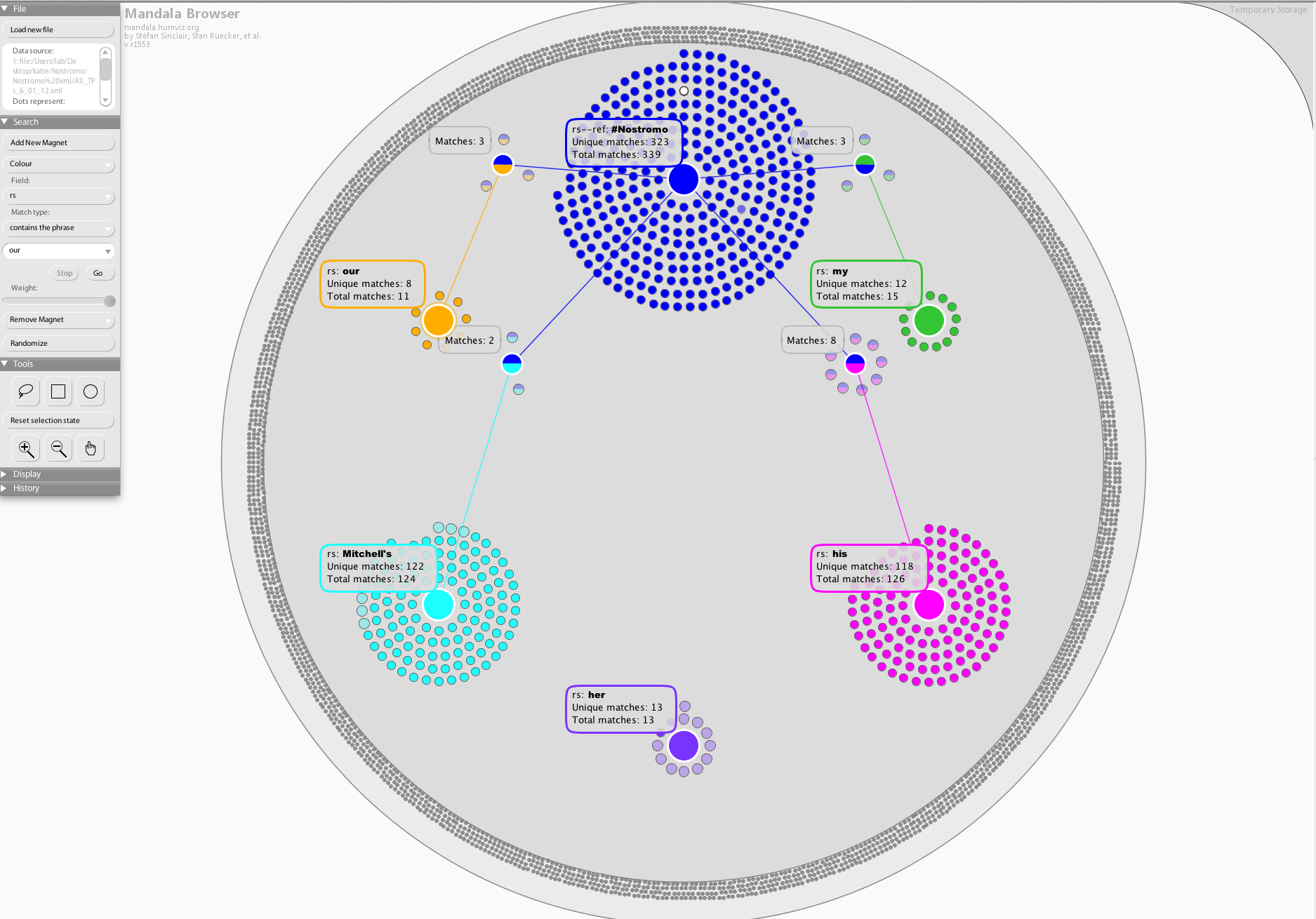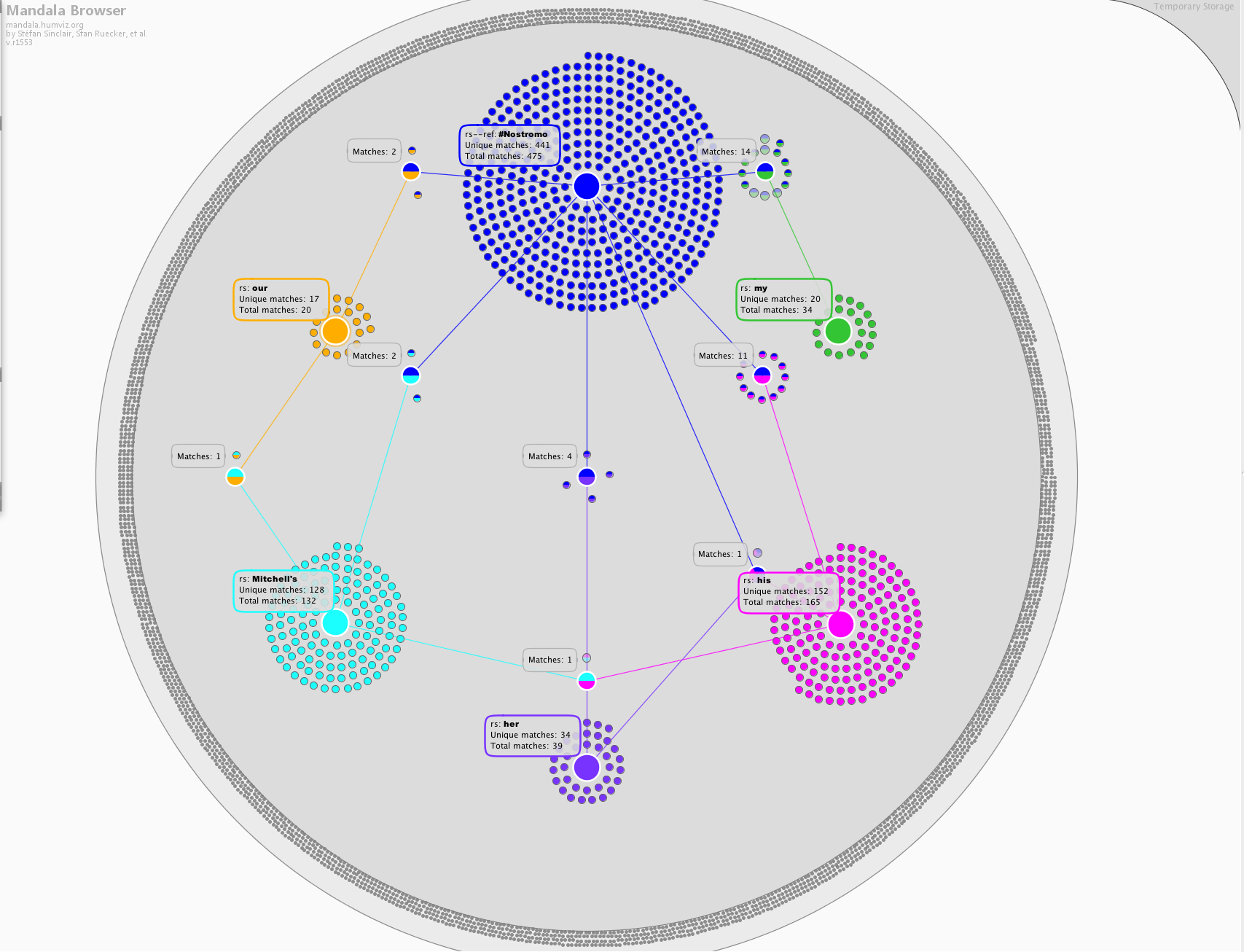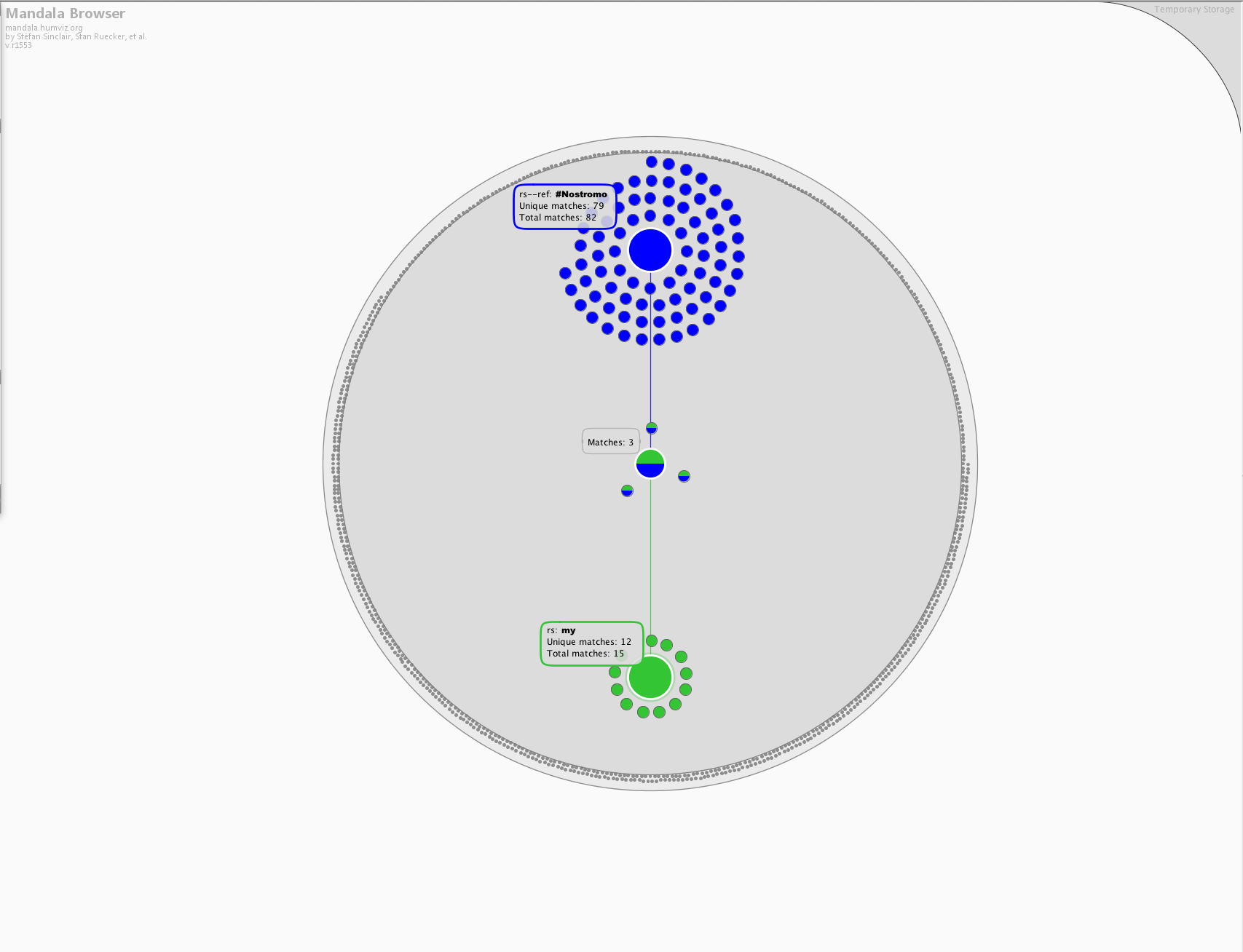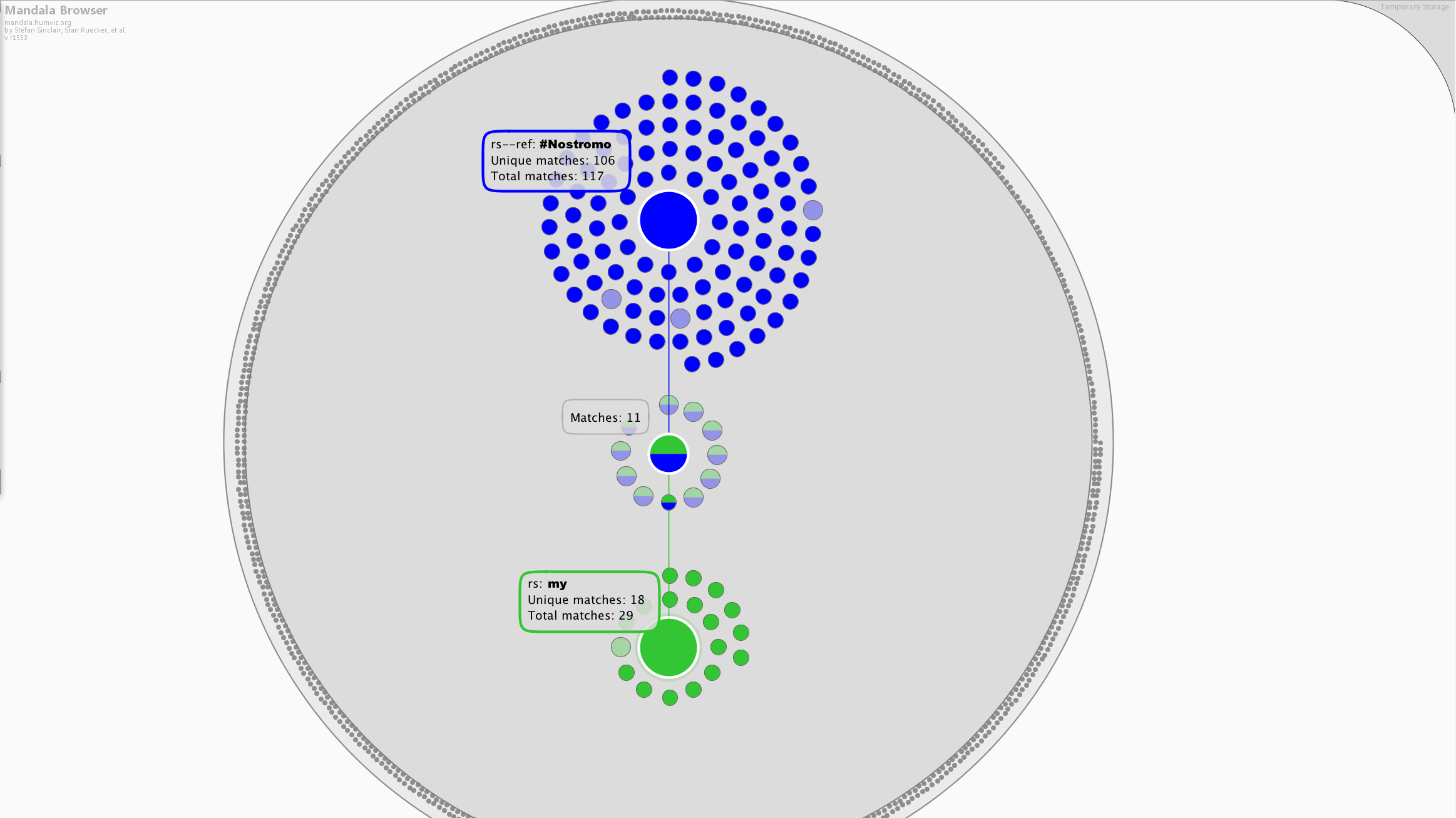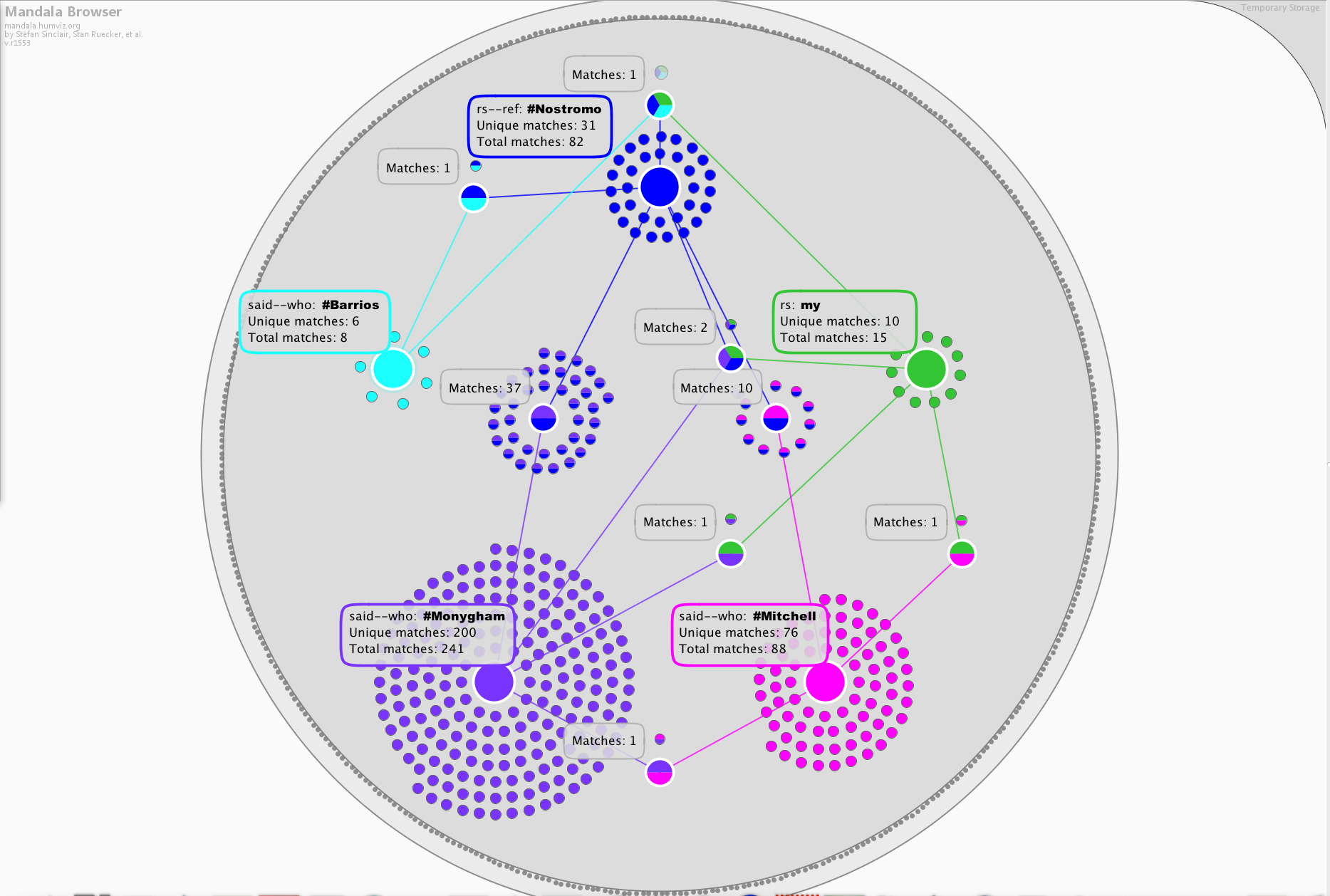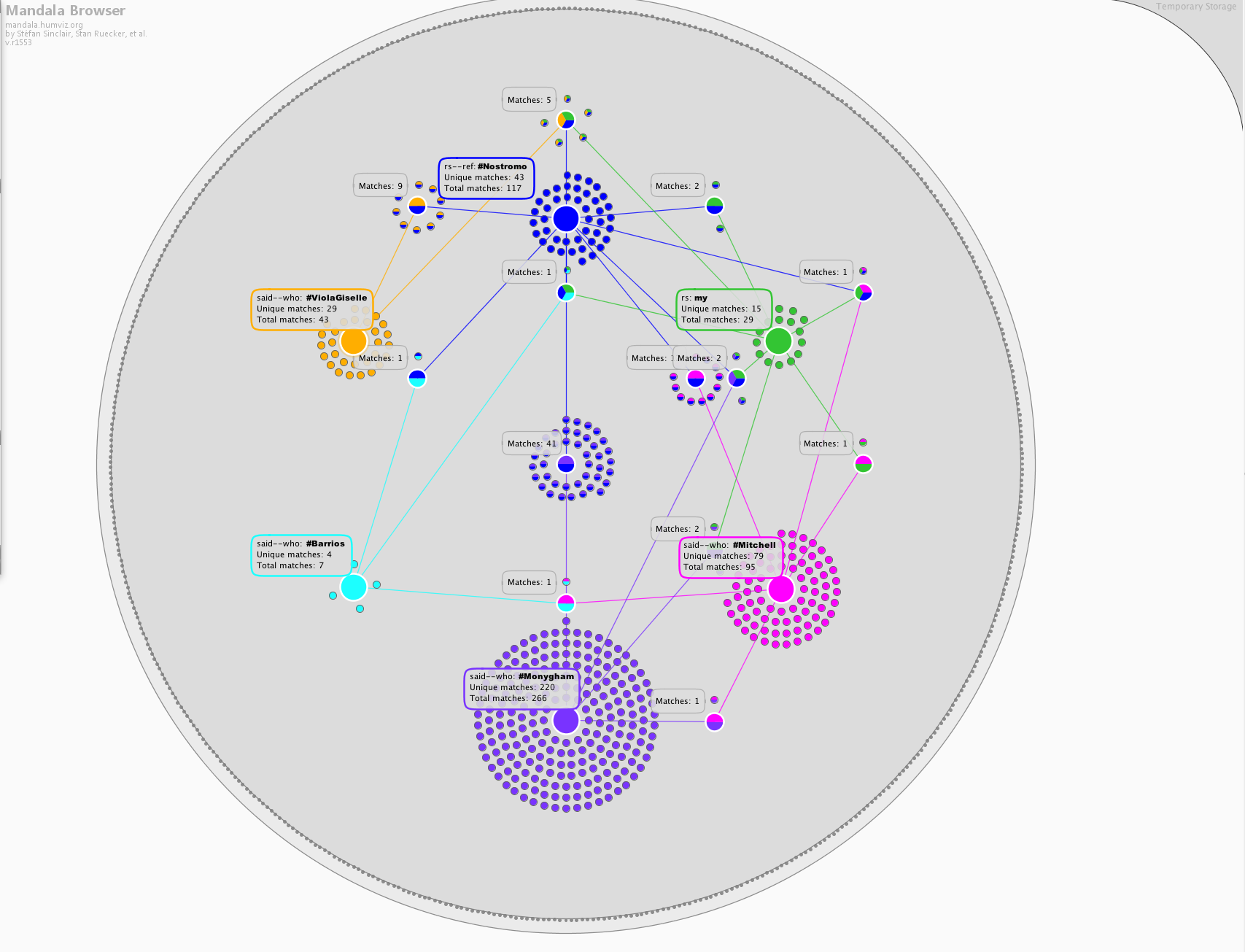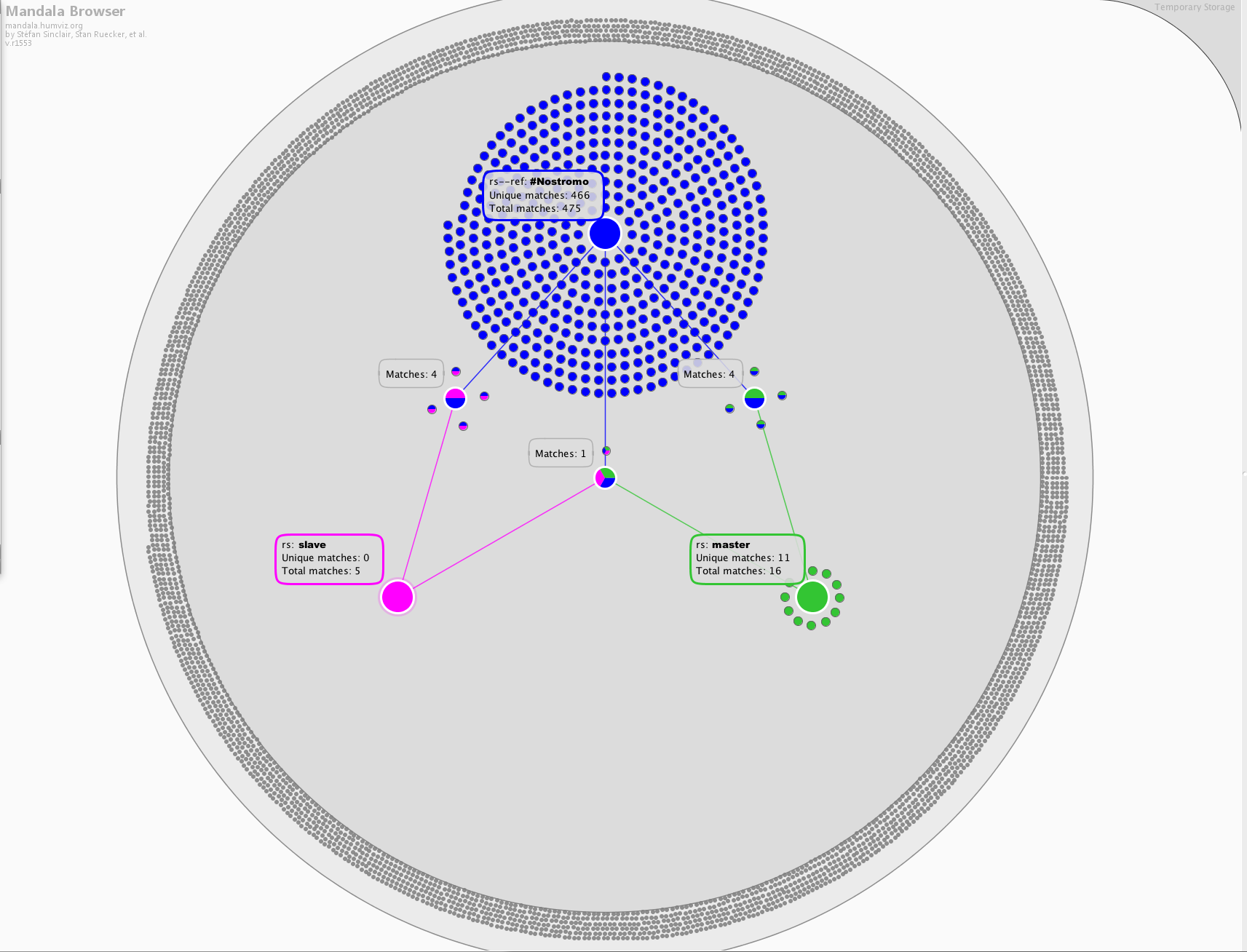Visualizing a Changing Nostromo
Katie Tanigawa, University of Victoria, Canada
© Katie Tanigawa. No part of this text may be reposted or republished without the permission of the author.
[4,570 words]
Developments in the digital humanities continue to expand the possibilities for exploring the relationships between serial publications and their later novel editions by allowing for the collation and visualization of major revisions, detailed edits, and the trends of revisions that run within and between texts. Conrad’s Nostromo is ideally suited to this particular digital approach to genetic criticism because of its evolution from a serial publication in T.P.’s Weekly and later publications as two unique but related novel editions. Although Nostromo continues to receive much critical attention, the texts studied are usually composites of the 1904 Harper edition and the 1918 Dent edition, rather than the 1904 T.P.’s Weekly serial (Watts 98). However, as the primary genetic critic of Nostromo, Cedric Watts, has shown, significant changes between the editions of this text mean how we understand Nostromo is heavily dependent upon which edition is being studied. Because of the substantial and incremental revisions between all three editions, genetic critical approaches to Nostromo can elicit new understandings of the texts as individual and related entities.
With the purpose of, as Jerome McGann writes, “expanding interpretational procedures” (McGann 2001, vii), a team consisting of Dr. Stephen Ross, Dr. Matthew Huculak, Dr. Jentery Sayers, Martin Holmes, Julian Gunn, and I are working on a project that digitally compares two editions of Nostromo for the Modernist Versions Project (MVP). Currently, part three of the T.P.’s Weekly and the 1904 Harper editions have been digitally rendered as a pilot for the project. Once complete, this resource will allow researchers to easily explore the variations of both global and specific, tagged content between texts and thus spend more time extrapolating the significance of these variations. The methodology used to uncover the differences in the varying editions of Nostromo involves scanning the different editions, OCR correcting, light structural mark-up to the text, semantic mark-up, and diffing to yield a display. The end product is an intensive mark-up of the variants using Extensible Markup Language (XML), to produce a searchable critical, digital edition.
Digital humanist approaches are not without their critics. On October 28, 2012, the Los Angeles Review of Books published an op-ed by Stephen Marche that criticized the digital humanities for reducing text to data. The aim of this project as with many other digital projects, however, is not just to treat texts like Nostromo as compilations of data sets, but to use digital means and algorithmic approaches to open up possibilities for further interpretations and understandings of texts. As McGann points out, the importance lies not simply in the data produced, but in “how [a tool] improve the ways we explore and explain aesthetic works“ (McGann 2004, xxii). In essence, digital humanities projects like the Nostromo versioning project, represent a complementary merger between an algorithmic, critical approach and traditional literary analysis.
Genetic Criticism and Nostromo
On 29 January 1904, T.P.’s Weekly published the first installment of Nostromo to mixed reviews. As Conrad himself admitted in 1909, his serial was “still mentioned now and again, and indeed kindly, sometimes in connection with the word ‘failure’ and sometimes in conjunction with the word ‘astonishing’” (Conrad 1909, 65). This failure and astonishment ran for thirty-six installments until 7 October 1904. As Peter Lancelot Mallios indicates, Conrad composed Nostromo between October 1902 and August 1904, writing close to deadlines and even requiring the assistance of Ford Madox Ford to finish the eleventh installment (Mallios 2008, 214–15). Though the composition was fraught with difficulties and the reception mixed, Harper & Brothers acquired the publication rights in 1903 and published a book edition of Nostromo seven days after the final installment appeared in T.P.’s Weekly (Watts 2007, 98).
Conrad gave the editors of T.P.’s Weekly a free hand in editing the work for serial publication (Watts 1989, 98), but he was much more scrupulous about the edits for the Harper’s book edition. In a letter to his agent, J. B. Pinker, he explained: “Whatever happens I must have proofs of the book. They can’t do better than send them out to me from N. York. I can’t let a book of mine go into the world without a careful personal revision” (Conrad 1983–2007, 3: 92). As a result, significant revisions from the serial text exist in the subsequent 1904 Harper edition. Conrad took a similar editorial approach to Dent’s 1918 edition of Nostromo, writing to Hugh R. Dent that despite Conrad’s revisions for the Harper’s edition, “The 1st Ed[ition] was most unsatisfactory. You’ll find several passages deleted bodily. Pray have all that carried out even if it costs some trouble. For they are really superfluous and this edition of Nostromo (the Cinderella of all my books) may even be reviewed as a new book” (Conrad 1983–2007, 6: 131). While Conrad wrote that “the changes are merely verbal and affect no more than a dozen words. Moreover I think you’ll approve—in the end” (Conrad 1983–2007, 6: 152–53), the revisions, even between the Harper and Dent editions, proved substantial. These “merely verbal” changes between the three editions include detailed revisions to names, locations, and events. The changes between the serial and the Harper editions also include more quantitatively substantial additions of paragraphs and plot that result in the Harper edition being 10,000 words longer than the serial.
The extent of these revisions means that readers experience different texts based on which edition of Nostromo they read. In 1989, Watts examined the comparative difference between the three texts, noting that there existed “many changes in dialogue, descriptive detail and character analysis” between the serial and Harper’s edition alone, and, moreover, that Conrad had “revised various specifications of time and distance in the endeavour to reduce inconsistencies” (Watts 1989, 100). In a subsequent article, Watts built on these observations of textual variants by touching upon selected inconsistencies between each edition, including the significance of the more than 10,000 word difference between the endings of the serial and Harper’s edition of Nostromo (Watts 2007, 102–112). The augmented ending in the novel takes a significant turn from the original, lending an almost operatic quality to the piece.
The Nostromo pilot for the MVP builds upon Watts’ groundbreaking work in the genetic study of Nostromo to produce a comparative analysis of the serial and Harper editions. Moving beyond issues of textual authority, it traces the forms of intertextuality that occur through the narrative economy created by the differences which Conrad imposed upon each text. Significant changes between editions, such as the various endings, and even smaller changes, such as deletions, name changes, and place changes, will be marked up within a digital framework in order to provide a comprehensive view of specific changes between texts for the purposes of genetic criticism.
Significance of Epithets
A critical point of genetic difference between the editions lies in how the different epithets applied to Nostromo produce different subjectivities for the character. In other words, when the character is called “Nostromo,” he does not inhabit the same subject position as he does when he is called “the capataz.” Likewise, he does not inhabit the same position when he is the capataz as he does when he is called “Gian’ Battista.”
Taking a Lacanian approach to identity formation in Nostromo, David Allen Ward inadvertently touches upon the way the shifting names of Nostromo allude to the character’s shifting identity. As Ward notes: “Certainly not without illusions is Nostromo himself, the magnificent Capataz de Cargadores, who for the Europeans of Costaguana is the very embodiment of competence and reliability, for the native Costaguaneros a charismatic leader, a man of the people” (Ward 1992, 294). Ward’s gesture to ascribe the qualities of magnificence, competence, and reliability, not to the name “Nostromo,” but to the name “Capataz de Cargadores,” highlights a trend in all three versions of the text. Nostromo becomes the “magnificent,” the “incorruptible,” and the “illustrious” when he is referred to as the “Capataz.” For instance, in the installment for 11 March 1904 the title character is described as “the greatly envied Capataz,” “the generous, the terrible, the inconstant Capataz,” “the dreaded Capataz,” and “the lordly Capataz” (340). All the modifiers denote power, prestige, or privilege. While “Nostromo” is also credited with being “tried and trustworthy” (340), the repetition is less vehement and is offered as a mere qualification to “the lordly Capataz de Cargadores, the indispensable man” (340).
Joshua Gooch’s insight into the origins of Nostromo’s name provide further insight into the correllation between Nostromo’s different epithets and his different subjectivities. Referencing Ian Watt’s work on the derivations of the name Nostromo, Joshua Gooch identifies possible genetic origins of Nostromo’s name as nostramo (Spanish: our master), naestramo (Italian: boatswain), or nostro uomo (Italian: our man) (Gooch 2010, 274). The possible lineages of Nostromo’s name, and the intertextual references between the various possibilities, function in a similar way to the genetic history of the serial and novel editions. As Gooch points out, these different meanings add to an understanding of Nostromo as a compilation of “conflicted collective subjectivities” (Gooch 2010, 274). This multiplicity also inscribes Nostromo further into a role of capitalist functionary. The name not only “traces [Nostromo’s] fall into opportunism” (274), but reveals Nostromo, the name, to be a force that ties him to his function as a master, a boatswain, or, if one considers the name to be a mispronunciation of nostro uomo, an object of and for Sulaco’s elite.
In all three editions, Linda decries the use of “Nostromo” as a moniker for the man she loves. After Decoud calls the man “Nostromo,” Linda says, “‘The English call him so, but that is no name either for man or beast’” (T.P.’s Weekly, 6 May 1904; Conrad 1904a, 593). “Nostromo” neither valorizes nor individuates the man she and her family call “Gian’ Battista”. Rather, “Nostromo” articulates the man as the sum of his economic functions. He is a mispronounced our man, a flawed articulation of possession. However, Decoud’s compromise, to call Nostromo “Capataz” (T.P.’s Weekly, 6 May 1904; Conrad 1904a, 593), is hardly a compromise, especially in the Harper edition. While the capitalization in T.P.’s Weekly provides a vestigial sense of Nostromo’s individuality and importance as a person, the loss of capitalization in Harper’s edition (Conrad 1904b, 257) reveals Decoud’s compromise as merely another, perhaps more insidious, inscription of Nostromo as an economic functionary. In this instance, there is no attempt to hide, through mispronunciation or capitalization, the base necessity for Nostromo, not as a person, but as a means to economic and political gain.
There seems to be a progressive division between the names given to Nostromo and their attributes. At first, “Nostromo” seems to be synonymous with “Capataz.” In the beginning of all three editions, both names are attributed to fear, noble actions, and reliability. “Nostromo” is the “invaluable fellow” (Conrad 1904b,134), someone whom Captain Mitchell declares “absolutely beyond reproach” (Conrad 1904b, 135). The “Capataz” is “‘much of a man’” according to the cargadores, a man of “value” according to Captain Mitchell, and a man under whom people “behaved very well” (Conrad 1904b, 135). By the middle of the novel, a split occurs. The narrator indicates “Nostromo’s mission is to save the silver” (T.P.’s May 13, 1904, 625); however, a few lines down Captain Mitchell notes that “the incorruptible Capataz de Cargadores is the man for that work” (T.P.’s Weekly, 13 May 1904, 625). The juxtaposition of these similar lines connotes a significant gap between the title character’s two personas. By this point in the story, a shift has taken place wherein “Nostromo”—”our man,” the flawed man, the possessed man—is the one who takes the job. However, the “Capataz” who is “magnificent” and “incorruptible,” is the ideal character to safeguard the silver. The capataz, not Nostromo, is the tried and trustworthy economic functionary. The narrator reveals that Dr. Monygham makes a similar distinction between the trustworthiness of Nostromo and the capataz after Nostromo returns to Sulaco from his mission to save the silver. The narrator describes Monygham’s reaction to Nostromo’s reappearance in Sulaco: “Nostromo’s return was providential. . . . The Capataz for him was the only possible messenger to Cayta. The very man” (T.P.’s Weekly, 9 September 1904, 325). While Monygham ascribes Nostromo’s return to a kind of divine intervention or luck, the Capataz is again the man for the important job.
This radical alterity in Nostromo’s character evolves further in the following chapter in the serial version when he visits Teresa before departing on his mission. Throughout the episode, the narrator alternates between referring to him as “Nostromo” and “Capataz”. The previous chapter establishes a division between Nostromo as the man who has the mission but the Capataz as the man for the job. His interactions with Teresa in this chapter reveal a widening divide between the perception of “Nostromo” as flawed and “the Capataz” as self-assured, “magnificent,” and “great” (T.P.’s Weekly, 13 May 1904, 627). It is “the Capataz” who first listens to Teresa’s dying request for a priest, but “Nostromo” who shakes his head and refuses. “The Capataz” is described in his upstanding attire, with “a red sash wound around many times around his waist, and a heavy silver ring on his forefinger” (T.P.’s Weekly, 13 May 1904, 627). In contrast, “Nostromo” is the man who “stood for a time as if struck dumb” (T.P.’s Weekly, 13 May 1904, 627). From the moment he is described as “struck dumb,” his actions will be ascribed to “Nostromo”. In this moment of failure, Nostromo cannot be “the Capataz”, as Dr. Monygham mockingly remarks: “Why, Capataz! I thought you could never fail in anything” (T.P.’s Weekly, 13 May 1904, 627). By establishing and enforcing the delineation between names and qualities, Conrad reveals that it is not “the Capataz” who has failed but “our man” Nostromo.
Epithet Changes Across Editions
The significance of Nostromo’s changing epithets across editions also extends to characterization. On a basic level, the stylistic genetic transformation between the editions from “Capataz” to “capataz” points to a progressive reduction of the titular character from individual to functionary. While the serial presents “Capataz” as a proper noun, the Harper’s edition demotes “capataz” to a mere descriptor of function within an economic framework. In the Harper’s edition, “capataz” no longer emphasizes the significance, not of the individual over the character’s title, but of the individual’s function within the economy. The lower-case “capataz” is inscribed with an ironic undertone, its decapitalization serving to undercut the grand descriptions that often accompany Nostromo’s title. Captain Mitchell’s reference to Nostromo as “my capataz de cargadores” in his praises of the man (Conrad 1904b, 13) reveals a stark disparity between the two men, and textually reveal Nostromo’s role as both the inferior and the possession of the bumbling Captain from the outset. In the serial “Capataz” develops as a strong individual from the beginning, thereby making his fall at the end especially tragic, whereas the Harper’s edition, in rendering “capataz” in lower case implicitly presents Nostromo as a social inferior who is unwittingly loyal despite being merely a dispensable economic functionary in an era of sprawling global capitalism.
What these name-changes reveal is a significant difference between how the texts portray the development of Conrad’s central characters. For example, the modification of Nostromo’s names throughout the texts becomes integral in a genetic analysis of the scene where Nostromo, after leaving Decoud on the Great Isabel with the silver, wakes up in the old fort. Nostromo’s transformation in this scene is arguably the central turning point in the novel. However, the magnitude of Nostromo’s transformation during this scene changes from edition to edition. In the serial version, we are told that “the Capataz of the Cargadores, lifting his eyes up to the sky, muttered, ‘I am not dead yet’” (26 August 1904, 263). Although this wording is retained in the Harper edition, it de-capitalizes his name in a fashion that becomes increasingly common in the rest of the novel (Conrad 1904b, 460). By the time of the Dent edition, however, it is not “the Capataz” but “Nostromo” who makes this proclamation: “Nostromo, lifting his eyes up to the sky, muttered, ‘I am not dead yet’” (Conrad 1947, 413). In the serial, by contrast, it is the magnificent “Capataz” who refuses to give up the ghost. Given the distinct connotations associated with “capataz” as opposed to “Nostromo,” the serial at this moment still offers the man hope. Although the Harper version retains the same wording, its de-capitalizing of Nostromo’s title imbues the moment with irony: the magnificent economic functionary is not dead yet. In the Dent edition, by contrast, Conrad seems to realize that this moment when all is lost: it is not the hero, the “Capataz”/”capataz” who survives, but the flawed and tragic “Nostromo.”
Where the earlier editions had suggested the possibility of hope, the Dent edition precludes it entirely. By this point in the later edition, the hero is dead; only the flawed man remains, the one whose name is “fit neither for man or beast” (Conrad 1947, 232) Because Nostromo’s personality is “the only thing lost in that desperate affair” (T.P.’s Weekly, 9 September 1904, 325) in all three editions, the question becomes which persona is lost. If it is “the Capataz” who is not dead yet, then the narrator leaves open the possibility that magnificence and virtue still remain in the character. If the “capataz” is not dead yet then the part of him that exhibits loyalty to his economic function may still remain. However, if “Nostromo” is the personality that survives, the possibility of hope is lost. The question, hitherto difficult to analyze, is whether or not such minute but progressive differences pervade the rest of the texts and affect a reading of the text. In the case of name changes in Nostromo, the real question is whether or not these progressive changes reveal a progressive development of Nostromo as a possession within the developing economic system of Costaguana.
Having noted the importance of epithets in relation to the progressive revisions of epithets attributed to characters across the text, Julian Gunn and I encoded Part Three of the T.P.’s Weekly serial and the 1904 Harper edition in order to highlight the use of epithets across editions. After the text was digitally rendered and marked for epithets using the Textual Encoding Initiative’s (TEI) guidelines for Extensible Markup Language (XML), I ran the two editions through the Mandala Browser, an interface that visualizes relationships between XML-encoded content. Although our interpretations are limited, in part by the scope of the encoding (i.e., only the third section of each version has been encoded in its entirety), the resulting visualizations reveal a progressive trend in the construction of Nostromo as a possession in and between these sections of the two editions. Moreover, this progression occurs primarily during the romance plot that is absent from the serial but present in the subsequent novel editions.
Nostromo’s Romantic Possession
In marking up the editions, one of our aims was to capture the instances where Nostromo was referred to with a possessive, such as “his Nostromo” (T.P.’s Weekly, 30 September 1904, 421; Conrad 1904b, 544); “my master” (Conrad 1904b, 602); “our great Nostromo” (T.P.’s Weekly, 7 October 1904, 454; Conrad 1904b, 574). My starting assumption was that we would find that Captain Mitchell, Dr. Monygham, or Charles Gould exerted a growing linguistic “possession” of Nostromo. As Stephen Ross points out in Conrad and Empire (Ross 2004, 133), it is Captain Mitchell who “persistently refers to Nostromo as a possession of the O.S.N. Company, gradually developing a ‘mania for ‘lending you my Capataz de Cargadores’’” (Ross 2004, 133). However, the collated data from the marked-up documents reveal that, in Part Three, this linguistic possession is enacted by Giselle, not Mitchell. Furthermore, she linguistically possesses Nostromo in the very part of the text that is so readily dismissed and, as Jeffers puts it, is “praised by no one I’ve read” (Jeffers 2003, 94).
The discovery of Giselle’s possession through the visualized data occurred in several stages. The first set of visualizations shows us how many times Nostromo is referenced in Part Three of each edition, and how times he is referenced by possessive determiner such as “my,” “our,” “his,” “hers” and “Mitchell’s.”
Figure 1. T.P.’s Weekly
Figure 2. Harper
The information collated and visualized by the Mandala Browser first reveals that “Nostromo” is referenced on over one hundred more occasions in the Harper’s edition than the serial.
Table 1.
| Nostromo referenced in T.P.’s | Nostromo referenced in Harper |
|---|---|
| 339 | 475 |
In itself this comes as no surprise, given that 10,000 words were added to the final section of the Harper’s edition. What makes the visualization significant, rather, is that it reveals the difference between the use of possessive determiners in relation to Nostromo, especially the determiner “my.”
Table 2.
| Possessive | T.P.'s | Harper |
|---|---|---|
| my | 3 | 14 |
| his | 8 | 11 |
| her | 0 | 4 |
| Mitchell's | 2 | 2 |
| our | 3 | 2 |
In the Harper edition, Nostromo is referred to as the speaker’s personal possession on eleven more occasions than in the serial. By using “my” as a possessive determiner of for, the Harper edition emphasizes the protagonist’s status as an inscribed possession more heavily than the serial. The question then becomes: how is Nostromo possessed differently in the novel, and by whom?
To answer this question, I asked Mandala to find all the instances where different forms of “my” plus the different iterations of “Nostromo” were referred to in a character’s speech (including Nostromo’s own words).
Figure 3. T.P.’s Weekly
Figure 4. Harper
Table 3.
| T.P.’s: characters referencing Nostromo in dialogue | Harper: characters referencing Nostromo in dialogue |
|---|---|
| 82 | 117 |
From there I refined the search to show who referenced Nostromo using the personal possessive determiner “my.”
Figure 5. T.P.’s Weekly
Figure 6. Harper
Table 4.
| Character using “my” of Nostromo | T.P.'s | Harper's |
|---|---|---|
| Mitchell | 0 | 1 |
| Giselle | 0 | 5 |
| Barrios | 1 | 1 |
| Decoud | 0 | 1 |
| Monygham | 2 | 2 |
| Total | 3 | 10 |
The Mandala Browser’s collation of the TEI data reveals that Giselle overwhelmingly possesses Nostromo in the novel. However, she does not possess him at all in T.P.’s Weekly. What can’t be shown by the images alone is the Mandala Browser’s added capability of identifying the location and context of the data points. Each dot points back to a place in the TEI-marked up text. In the case of Giselle’s iterative possession of Nostromo, all these instances occur in the romance plot. Scholars such as Jeffers have dismissed the romance plot as a section: “where [Nostromo] woos and [Giselle] coos in the style of genteel pulp. When he’s not cruising or courting, however, Nostromo is of real interest” (Jeffers 2003, 94). And yet this section is in fact central to the way in which the character of Nostromo is constructed. It is in the romantic plot and through his romantic interest that Nostromo is possessed.
The inter-edition transformation in the relationship between Nostromo and his role as a possession of others is further complicated by his association with the word “slave” in the serial version and with both the words “slave” and “master” in the Harper’s version.
Figure 7. T.P.’s Weekly
Figure 8. Harper
This comparative overview of the texts throws into relief an emerging tension in the inter-edition development of Nostromo’s character. In the serial, Nostromo is only referred to as the “slave of a treasure” (T.P.’s Weekly, 7 October 1904, 455). Harper’s, meanwhile, refers to him to as “slave” four times, as “master” four times, and as both “slave” and “master” once. In the Harper’s version, Nostromo is not simply linguistically possessed through possessive determiners and through a description as a slave; he also becomes someone who possesses in return. Again, this linguistic shift between the texts occurs as a result of the added romance plot. It is Giorgio Viola who first refers to Nostromo as a master, calling him him Linda’s “master” (Conrad 1904b, 594). Later, Giselle linguistically figures Nostromo as her master (Conrad 1904b, 602, 604). This tension in the Harper edition culminates in the phrase, “master and slave of the San Tomé mine” (Conrad 1904b, 619); the serial, by contrast, can only refer to Nostromo as the “slave of a treasure” (T.P.’s Weekly, 7 October 1904, 454). Nostromo’s ability to inhabit a more complex position,of both master and slave is only made possible through the romance plot, which presents Nostromo as retaining a position of mastery.
Both the substantial and the progressive changes between the serial and novel editions of Conrad’s works reveal that differences between versions of the text can have significant impact on the interpretation of the work. While they are all genetically linked, the serial, the Harper edition, and the Dent edition are, in a sense, different texts and lend themselves to divergent readings. In the case of the romance plot added to the Harper’s edition, its absence from the serial is what highlights its importance. In the case of Nostromo’s changing names in the awakening scene mentioned above, a comparative analysis of the editions reveals a progressive development of Nostromo as an object of material interests. New digital resources and tools—including as the digital archiving of Conrad’s periodicals by Conrad First, the visualization capabilities and algorithmic approaches to texts made possible by the Mandala Browser, and the TEI markup and versioning being pursued by the MVP and programs such as Juxta—promise to expand access to these distinct versions of the texts and, in so doing, enable new ways of understanding the relationship between the variant editions of Conrad’s works.
Works Cited
Conrad, Joseph. 1983–2007. The Collected Letters of Joseph Conrad. Ed. Frederick Karl and Laurence Davies. 9 volumes. Cambridge: Cambridge University Press.
-----. 1947. Nostromo. London: Dent.
-----. 1909. “Some Reminiscences.” English Review (April): 59–69.
-----. 1904a. “Nostromo.” T.P.’s Weekly, 29 January–14 October.
-----. 1904b. Nostromo. London: Harper Bros.
Foucault, Michel. 2001. “From Truth and Power.” In The Norton Anthology of Theory and Criticism, ed. Vincent B. Leitch et al, 1667–70. New York: Norton.
Gooch, Joshua. 2010. “‘The Shape of Credit’: Imagination, Speculation, and Language in Nostromo.” Texas Studies in Literature and Language 52.3: 266–97.
Hawthorn, Jeremy. 2007. “Joseph Conrad’s half-written fictions.” The Cambridge Companion to The Modernist Novel, ed. Morag Shiach. 151–64. New York: Cambridge University Press.
Jeffers, Thomas L. 2003. “The Logic of Material Interests in Conrad’s Nostromo.” Raritan 23.2: 80–111.
Mallios, Peter Lancelot. 2008. “Introduction: Untimely Nostromo.” Conradiana 40.3: 213–32.
McGann, Jerome. 2010. “Electronic Archives and Critical Editing.” Literature Compass 7.2: 37–42.
-----. 2008. “The Future Is Digital.” Journal of Victorian Culture 13.1: 80–88.
-----. 2001. Radiant Textuality: Literature After the World Wide Web. Basingstoke: Palgrave Macmillan.
-----. 2001. “Visible and Invisible Books: Hermetic Images in N-Dimensional Space.” New Literary History 32.2: 283–300.
Ross, Stephen. 2004. Columbia, Mo.: University of Missouri Press.
Ryan, Kiernan. “Revelation and Repression in Conrad’s Nostromo.” Modern Critical Interpretations: Nostromo, ed. Harold Bloom, 43–56. New York: Yale University Press.
Ward, David Allen. 1992. “‘An Ideal Conception’: Conrad’s ‘Nostromo’ and the Problem of Identity.” English Literature in Transition 35.3: 288–98.
Watts, Cedric. 2007. “Nostromo in T.P.’s Weekly.” Yearbook of Conrad Studies 3: 97–113.
-----. 1989. Joseph Conrad: A Literary Life. London: Macmillan.
White, Andrea. 2004. “Conrad, Language, and Narrative [review].” English Literature in Transition 47.4: 470–75.
 Katie Tanigawa is a postgraduate student at the Department of English, University of Victoria, Canada, where she is working under the direction of Dr. Stephen Ross on a project for the Modernist Versions Project (MVP), an online database for comparative editions of various Modernist texts. Her doctoral project, which focuses on the three main textual variants of Nostromo, will serve as a research tool for scholars interested in the genetic criticism of Conrad’s works.
Katie Tanigawa is a postgraduate student at the Department of English, University of Victoria, Canada, where she is working under the direction of Dr. Stephen Ross on a project for the Modernist Versions Project (MVP), an online database for comparative editions of various Modernist texts. Her doctoral project, which focuses on the three main textual variants of Nostromo, will serve as a research tool for scholars interested in the genetic criticism of Conrad’s works.
Back to the start of the essay.
